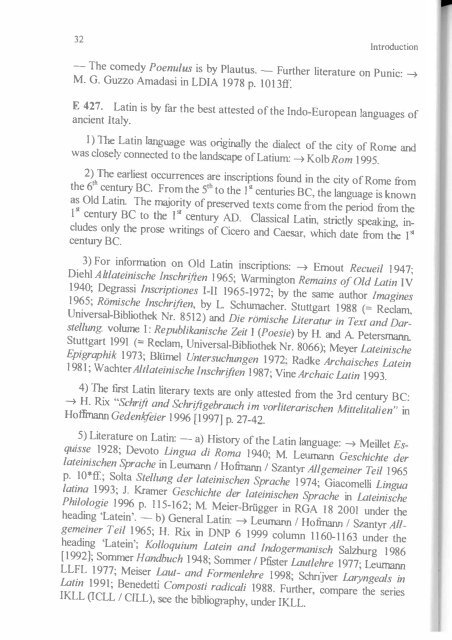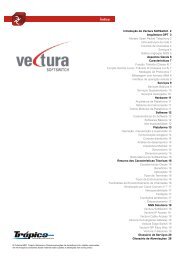Create successful ePaper yourself
Turn your PDF publications into a flip-book with our unique Google optimized e-Paper software.
32lntroouction- The comedy Poenulus is by Plautus. - Further literature on Punic: M. G. Guzzo Amadasi in LDIA 1978 p. 1013ff.E 427. Latin is by far the best attested <strong>of</strong> the Indo-European languages <strong>of</strong>ancient Italy.I) The Latin language was originally the dialect <strong>of</strong> the city <strong>of</strong> Rome andwas closely connected to tbe landscape <strong>of</strong>Latium: Kolb Rom 1995.2) The earliest occurrences are inscriptions fo und in the city <strong>of</strong> Rome fromthe 6t h century BC. From the 5t h to the I" centuries BC, the language is knownas Old Latin. The majority <strong>of</strong> preserved texts come from the period from the, " century BC to the I" century AD. Classical Latin, strictly speaking, includesonly the prose writings <strong>of</strong> Cicero and Caesar, which date from the I "century BC.Overview <strong>of</strong> the lndo--European Languages and their Sources 33o6) Of particular importance is also Vulgar Latin, .the spoken language <strong>of</strong> which in the various Roman provinces the indiVIdual Romance languagg:ta1an, and Portugese) developed. In a unique way, the relatlonshi oomanian, Romansch, Sardic, French, Dalmatian, Italian, Prove .nyaj, Sparush,:: Latin: ViiiWinen Latin vulgaire 1981.ther language to its <strong>of</strong>lSpring may be observed and documented. nE 428. The oldest occurrences <strong>of</strong> Faliscan, the language <strong>of</strong> Falerii and thesurrounding area, are inscriptions from the 6t h cent BC; the latest Falis-. . ean msenp t'o I ns are from the 2,d century BC. ASIde from the sparse m-.script ions there are no attestations <strong>of</strong> Faliscan. L' Iter t ure: -: Veller .Handbuch der italischen Dialekte I 1953 p. 277ff.; Glacomelli LmguaFalisca 1963; G. Giacomelli in LDIA 1978 p. 505ff.3) For information on Old Latin inscriptions: Emout Recueil 1947;Diehl Alllaleinische lnschriften 1965; Warmington Remains oJ Old Lalin IV1940; Degrassi inscripliones I-IT 1965-1972; by the same author Imagines1965; Romische inschriften, by L. Schurnacher. Stuttgart 1988 ( Reclam,Universal-Bibliothek Nr. 8512) and Die romische Lileralur in Texl and Darslellung.volwne I: Republikanische Zeil r (Poesie) by H. and A. Petersmann.Stuttgart 1991 ( Reclam, Universal-Bibliothek Nr. 8066); Meyer LaleinischeEpigraphik 1973; Bliimel Unlersuchungen 1972; Radke Archaisches Lalein1981; Wachter Alllaleinische Inschriften 1987; Vine Archaic Lalin 1993.4) The first Latin literary texts are only attested from the 3rd century BC: H. Rix "Schrift and Schriftgebrauch im vorlilerarischen Millelilalien" inH<strong>of</strong>finann Gedenlif€ier 1996 (1997] p. 27-42.5) Literature on Latin: - a) History <strong>of</strong> the Latin language: Meillet Esquisse1928; Devoto Lingua di Roma 1940; M. Leurnann Geschichle derlaleinischen Sprache in Leurnann / H<strong>of</strong>rnann / Szantyr Allgemeiner Teil 1965p. 10·ff.; Solta Slellung der laleinischen Sprache 1974; Giacomelli Lingualalina 1993; 1. Kramer Geschichle der lateinischen Sprache in LateinischePhilalogie 1996 p. 115-162; M. Meier-Briigger in RGA 18 2001 under theheading 'Latein'. - b) General Latin: Leurnann / H<strong>of</strong>rnann / Szantyr AllgemeinerTeil 1965; H. Rix in DNP 6 1999 column 1160- 1163 under theheading 'Latein'; Kolloquium Latein and indogermanisch Salzburg 1986[1992]; Sommer Handbuch 1948; SOmmer / Pfister Lautlehre 1977; LeumannLLFL 1977; Meiser Laut- and Formenlehre 1998; Schrijver Laryngeals inLatin 1991; Benedetti Composti radicali 1988. Further, compare the serieslKLL (I CLL / ClLL), see the bibliography, under lKLL.E 429.Among the languages <strong>of</strong> the Sahellian branch <strong>of</strong> languages are socalledSouth Pieene, Oscan, Umbrian, and a couple <strong>of</strong> other, only sghtlyvarl'ed languages , such as Volscian. Of partlcuiar mterest IS South PlC en e,the oldest attestations <strong>of</strong> which date from t h e 6t h cen t ury BC . Sout h p1-cene is particularly interesting. Three different alphabets were employe mOscan inscriptions: the Greek alphabet, the Latin Iphabet, and the Oscru:alphabet. The oldest inscriptions date from the 3.century BC.d .The socaUed Iguvine Tables are the main source for Umbnan and come from the3' " _2, d centuries BC.Literature: Meiser Umbrisch 1986; G. Meiser, Pailgmsch, Latemund Sudpikenisch in Glotta 65 1987 p. 104-I 25; H. Rix Umbro e Pto:Osco- Umbro in Convegno Udine (mmor language ) 1991 [1993], arl. . . . ..nett! !scnzlOm sudplcene 1985' , G. M else ' rand H Rix m Tavole dl Agnone'1994 [1996] p. I 87ff. and p. 243ff.; H. Rix, Sudpikemsc . h kd u/u . . III ' HS 1071994 p. 105-122; Schirmer Wortschatz 1998; Untermarm WorterbuchOskisch-Umbrisch 2000.. . .E 430. Venetian represents a separate Italic languạge <strong>of</strong> what is now t?Veneto region (inscriptions from the 6t h _2, d centurIes BC): PeUegnruProsdocimi Lingua Venelica 1 / II 1967; Lejeune Venele 1974; A. L. Prosdocimi11 venetico in LDIA 1978 p. 257/f by the same author m ConvegnoUdine (minor languages) 1981 [1983] p. 153ff.E 431. Celtic can roughly be divided into Continental Celtic (from theEminent) and Insular Celtic (from the Bnllsh Isl s [and fromth':r::Oh migrations, Brittany connects linguistically WIth Breton D.





